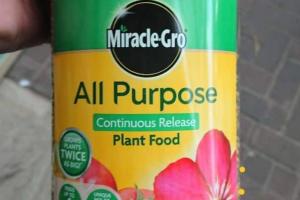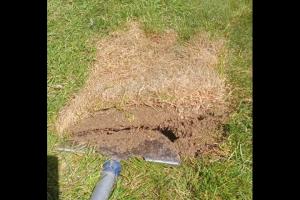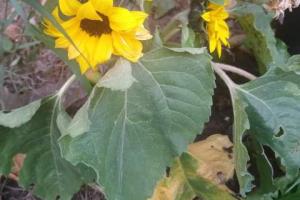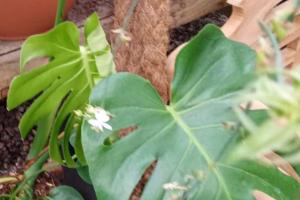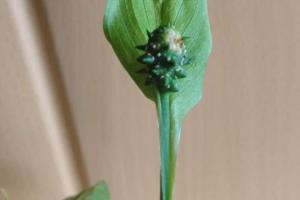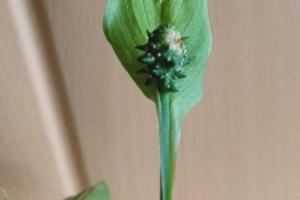How to Revive a Dying Venus Fly Trap
The most common cause for a sickly, dying Venus fly trap is because of not enough direct sunlight. Venus fly traps grow in open areas in intense direct sunlight. If the plant is in the shade the traps turn from red to green and the plant starts drooping and dying.
However it should be noted, most Venus fly traps can turn black and die back every year.
Here is a table summarizing the most common reasons for dying Venus fly trap plants…
| Symptoms of a Dying Venus Fly Trap: | Reasons for a Venus Fly Trap Dying: |
| Venus fly traps turning black and dying: | All the leaves/traps turn black and die before Winter dormancy when grown indoors. Individual traps also turn black and die back periodically as part of the plant’s life cycle. |
| Traps turning yellow: | Tap water (rather then rain water) causes yellowing leaves. Too much fertilizer and water stress also cause yellowing. Plants turn yellow after flowering due to the energy requirements when developing seeds after flowers. |
| Venus fly trap drooping (and losing its red colour): | Drooping is almost always not enough direct sunlight or underwatering combined with low humidity. Overwatering can also cause drooping Venus fly traps. |
| Venus fly trap not closing: | Each individual fly trap only closes 4 or 5 times before dying back. |
Keep reading to learn why your plant is dying and how to implement the solutions to save it…
Why is my Venus Fly Trap Turning Black and Dying?
If your Venus fly trap is turning black in Winter, with an all round dying appearance then there is nothing wrong with the plant as it is entering a state of Winter dormancy.
As the number of day light hours reduces and the intensity of the sunlight decrease then the Venus fly trap naturally enters a state of dormancy as a survival strategy to preserve its resources.
All the leaves and traps die back, but they come back the following year in response to longer days and brighter light.
It should be noted that whilst a Venus fly trap turns black and appears to die back each Winter in its native environment of North and South Carolina, it does not necessarily have to die back indoors.
If you provide the plant with additional light (via a grow light) and ensure it gets around 12 hours of light per day and keep it at room temperatures then the Venus fly trap can maintain its green and red healthy appearance all year long.
Individual traps may also turn black and die at anytime of year whilst the rest of the traps remain healthy. This is because each trap only lasts a few months typically before dying back which typically stimulates new growth.
Once the traps have turned black they are no longer performing a function for the plant and you can cut the trap back to the base of the plant, carefully with a sharp pair of pruners.
If its is before the Winter dormancy then new traps grow to replace the blacked traps.
I should also note that whilst Venus fly traps need lots of sunlight, they can scorch if they are moved from a relatively shaded spot straight into intense sunlight. Venus fly traps can scorch yellow, black or brown depending in the extent of the sun burn.
I find this typically happens when Venus fly traps have been stored indoors, in somewhat lower light when for sale in stores and garden centers where they are forced to adapt to lower light levels, then brought home and placed in blazing sunshine in Spring or Summer without the chance to adjust to a sudden increase in light intensity.
In this scenario I recommend gradually exposing your Venus flay trap to more hours of light over the course of 2 weeks, starting off with morning light, then leaving the plant in the sun a bit longer each day. This should give the plant the chance it needs to acclimatize to the bright light without scorching. The plant should be just fine and recover well.
Venus Fly Trap Turning Yellow
The most common reason for Venus fly traps turning yellow is usually because they have been watered using tap water. In certain areas tap water can be much harder then others (contain more minerals). As hard tap water contains more minerals and potentially chlorine and fluoride.
Venus fly traps are more sensitive to tap water then most other houseplants.
These minerals can build up and prevent the roots from functioning properly, making it more difficult to draw up moisture resulting in yellowing leaves.
Fertilizer in pre-made potting mixes can also result in the leaves turning yellow. Venus fly traps are native to areas with very low soil nutrients (which is why they have adapted to attain their nutrients from captured insects) and they prefer not to have any additional nutrients in their potting soil.
Houseplant fertilizer is also necessary for the same reasons.
Overwatering, poor drainage and underwatering are also common reasons for yellowing leaves. Venus fly traps need a constant source of moisture and if the soil dries out completely they leaves turn yellow or the traps can lose their red colour and droop.
Whilst Venus fly traps need the soil to be moist, if it is saturated for too long, the leaves can also turn yellow and droop.
Venus fly traps do of course flower, but as indoor gardeners, it is in our interest to cut back any emerging flower stems as this causes the plant to redirects its energy into producing seeds. this redirection of energy takes significant resources away from the plant and often causes the Venus fly trap to turn yellow as a result.
How to Revive a Yellow Venus Fly Trap
The key to saving a yellow Venus fly trap is to water with distilled water or rain water, particularly if you live in a hard water area.
- I recommend watering generously with rainwater to help dissolve any excess minerals and flush them out of the soil which should help the roots function properly again.
- If you have added any fertilizer or if you have repotted your Venus fly trap, check the label to see if they have added any fertilizer to the potting soil. If so repot the plant into new compost.
- It is important to replicate the low nutrient, slightly acidic soil conditions of the Venus fly traps native environment. To emulate the native soil of the Venus fly trap mix 2 thirds ericaceous compost (peat moss for example) with around 1 third inorganic matter such as perlite, horticultural grit or sand.
- The grit or sand keeps the soil mix well draining to prevent any threat of root rot from boggy soil and as sand does not contribute nutrients to the soil, it reduces the fertility of the soil to a level similar to its native environment.
- Venus fly traps are grown for interest in their carnivorous habits rather then flowering, so I always recommend to trim back any emerging flowers as soon as you see them to preserve the energy of the plant, which should prevent it from turning yellow.
If you you follow the steps early then there is a good chance the Venus fly trap can recover from its yellow appearance.
Keep the Venus fly trap happy and it may show new signs of growth the following Spring. However, if it has sever root rot from boggy soil, then it is unlikely to recover.
Venus Fly Trap is not Red and is Turning Green and Drooping
The inside of each trap should be a deep red colour which functions as a way to draw in insects. If the inside of the trap is turning green and each trap is floppy and lying on the soil’s surface, then this indicates stress from overwatering, underwatering, low humidity or a lack of direct sunlight.
Venus fly traps need as many hours of direct sunlight as you can possibly give them. If the Venus fly trap has enough intense sunlight then the interior of the trap should be nice and red and indicates the plant is healthy.
However in low light, the traps turn green and droop due to a lack of energy.
If the Venus fly trap has enough direct sunlight then I find the reason for green, drooping leaves is specifically the combination of underwatering and low humidity.
Venus fly traps grow near wetland areas and their soil is usually evenly moist (but not saturated) and they live in consistently humid conditions.
The humidity indoors is typically much lower then their native Carolina environment hence why this problem is so common.
However, it should be noted that overwatering and low humidity can also be responsible for this problem.
How to Revive a Drooping Venus Fly Trap
To save it, it is essential that you increase humidity by misting the entire plant and move the plant into bright direct sunlight in a South facing window. Misting the plant immediately alleviates some of the stress that caused the problem.
However, it is recommended to keep Venus fly traps on a saucer of water. The water consistently evaporates which creates a humid micro climate that mimics the conditions of the Venus fly traps humid natural environment.
Place some pebbles in the water for the Venus fly trap’s pot to sit on so it sits just above the water to allow for drainage.
You can also use a plant humidifier (available online or from garden centers) which can increase the humidity with precision, but I only tend to recommend them if you have lots of houseplants requiring increased humidity.
Keep in mind that indoor heating, forced air and air conditioning can all lower humidity, so locate your Venus fly trap away from any air currents.
Once the Venus fly trap is back in full sun then it can start to recover, however if it is Summer (when sunlight is at its most intense) then I recommend gradually exposing the plant to strong sunshine gradually as moving from shade to full sun can scorch the plant.
Morning sun is more gentle then afternoon sun, so place the plant in the sun for a bit longer each day over the course of around 2 weeks so that the plant can adjust to greater light intensity without burning.
In terms of watering, it is essential to achieve a balance of consistent moisture without saturating the soil.
If you have added some inorganic matter to the potting mix (sand, grit or perlite) then achieving the optimal balance of moisture is much easier as the potting mix is well draining enough to mitigate the risk of root rot.
The best method is to just feel the soil with your finger and as soon as the surface starts to feel as though it is drying out give it a water.
Check that excess water can drain efficiently from the base of the pot, so that the soil does not become boggy and the Venus fly trap should recover.
Venus Fly Trap Not Closing
The reason for a trap not closing despite flies (or anything else) clearly moving around the trap is because it has shut too many times.
Each trap only shuts around 4 or 5 times in its life before dying back and being replace by a new trap. If you have interfered with the trap too often then this can prevent it from closing again.
By interfering with Venus fly traps too often you can drain its energy and reduce the number of viable traps. If the plant has less traps ready to close in on prey then it can be deprived of the nutrients it needs which can cause the plant to die back.
Leave the plant alone or feed the plant with blood worms (available from fishing stores) to give the plant energy and resistant the temptation to cause the trap to close for entertainment.
Key Takeaways:
- Venus fly traps turn black and die back before their Winter dormancy every Fall. They grow back new traps in the Spring.
- Occasionally an individual trap turns black and dies which is the normal part of the Venus fly traps life cycle.
- Venus fly traps turn yellow when water with tap water. The plant does not tolerate hard tap water very well as it is sensitive to the mineral content. Always water with rainwater to avoid a yellowing plant.
- If the inside of the traps turn from red to green and the plant starts drooping then this indicates the Venus fly trap does not have enough direct sunlight. Venus fly traps need full sun for the traps to stay red and healthy.
- Each individual trap only closes 4 or 5 times. If the trap has been provoked into closing unnecessarily too many times then they do not open again and the trap eventually dies back.
- To revive a dying Venus fly trap, recreate the conditions of its natural habitat by locating the plant in full sun, increase the humidity with regular misting and keep the potting soil evenly moist. Cut back any black, dying leaves to stimulate new growth.



